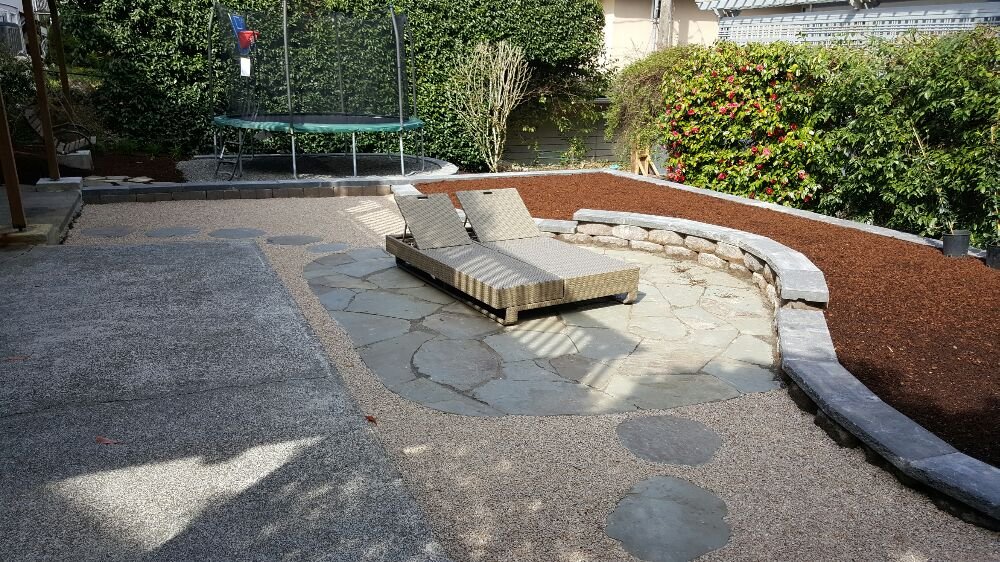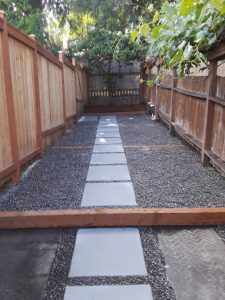Why Go for a Low-Maintenance Yard?
Let’s face it—life is busy, and not everyone has the time (or energy) to spend every weekend mowing, trimming, and weeding. A low-maintenance yard offers the beauty of a lush landscape without all the hard work. In Seattle, where the weather can be unpredictable, a low-maintenance yard is perfect for homeowners and landscapers who want a beautiful outdoor space that doesn’t demand constant upkeep. Here’s how to set up your own low-maintenance paradise!
How It Works: The Basics of a Low-Maintenance Yard
Creating a low-maintenance yard means designing a landscape that pretty much takes care of itself. Here are the core ideas:
- Less Lawn, More Plants: Lawns require mowing, watering, and fertilizing, so minimizing lawn space reduces maintenance.
- Native Plants: Choose plants native to the Pacific Northwest, as they naturally thrive in our climate with less care.
- Efficient Watering: Drip irrigation or soaker hoses keep plants watered without wasting water, saving you time.
- Mulching: Mulch helps retain soil moisture and blocks out weeds, cutting down on both watering and weeding.
- Hardscaping: Incorporating rock paths, patios, and gravel areas adds beauty and reduces the need for plant care.
Tools You’ll Need
Even a low-maintenance yard needs the occasional touch-up. Here are the essential tools:
- Mulch Spreader: Easily distribute mulch around plants and trees.
- Leaf Blower: Forget raking—just blow leaves away in minutes.
- Pruning Shears: Keep shrubs and small trees trimmed with occasional snips.
- Drip Irrigation Kit: Once installed, it handles watering for the entire season.
- Weed Barrier Fabric: Prevent weeds under mulch or gravel.
Best Low-Maintenance Plants for Seattle Yards
Seattle’s mild climate means there are great plant options that require minimal upkeep. Here are a few go-to choices for low-maintenance greenery:
- Sword Fern: A local favorite that thrives in shady spots and needs minimal watering.
- Lavender: Smells amazing, is drought-tolerant, and deer-resistant.
- Oregon Grape: This hardy shrub needs little care once established.
- Japanese Maple: Slow-growing and easy to maintain, perfect for those who don’t want to prune frequently.
- Evergreen Huckleberry: Great for hedges, this native shrub adds year-round color.
Best Practices for a Low-Maintenance Yard
- Choose Native Plants: Native plants are naturally suited to Seattle’s climate, handling both wet winters and dry summers with minimal care. They’re also more resistant to local pests.
- Mulch, Mulch, Mulch: Apply a thick layer of mulch around trees and shrubs. It keeps moisture in, suppresses weeds, and reduces the need for constant watering.
- Reduce Lawn Space: Lawns need regular mowing, watering, and fertilizing. Replace grass with garden beds, gravel paths, or a patio. Ground covers like moss or clover are great alternatives to traditional grass.
- Install Drip Irrigation: Set up a drip system or soaker hoses for efficient watering. Once installed, it’s low-maintenance and ensures your plants get the right amount of moisture.
- Go for Perennials: Perennials come back year after year, reducing the need for replanting. Go for low-maintenance options like daylilies or black-eyed Susans for continuous beauty.
Common Low-Maintenance Trees and Shrubs in Seattle
- Japanese Maple: Slow-growing, needs little pruning, and has stunning foliage.
- Western Red Cedar: Hardy and low-maintenance, ideal as a privacy screen.
- Boxwood Shrubs: These evergreen shrubs require minimal trimming and are perfect for creating low hedges.
- Vine Maple: A smaller native tree that’s perfect for Seattle’s climate, needing little pruning.
- Dwarf Mugo Pine: A compact, slow-growing pine that adds an evergreen element to your yard.
Low-Maintenance Yard Design Tips
- Plan Your Layout: Keep the design simple. Fewer plants, well-placed paths, and larger mulch areas mean less to maintain. Group plants with similar water needs together for more efficient watering.
- Choose Hardscaping: Incorporate rock paths, a stone patio, or gravel areas to reduce plant care. Hardscaping elements don’t need watering or mowing, making them perfect for a low-maintenance yard.
- Use Ground Covers: Replace grass with low-growing ground covers like creeping thyme, moss, or clover. These options require less water and no mowing, making them ideal for a low-maintenance yard.
- Zone Your Yard: Divide your yard into zones based on sunlight and water needs. This helps you place plants strategically and makes managing different areas easier.
How to Keep a Low-Maintenance Yard Looking Great
- Water Smart: Avoid overwatering! Many low-maintenance plants, especially native species, don’t need frequent watering. Use a drip system to water deeply but infrequently.
- Minimal Pruning: Choose plants and trees that don’t need frequent trimming. A quick prune once or twice a year is often enough to keep things tidy.
- Prevent Weeds Early: Lay down weed barrier fabric and cover it with mulch or gravel to save hours of weeding later on.
- Seasonal Checkups: Every season, do a quick once-over. Check for dead plants, clean up debris, and replace mulch as needed.
Final Thoughts
Creating a low-maintenance yard in Seattle is not only possible—it’s a smart choice! By selecting the right plants, reducing lawn space, and incorporating efficient watering systems, you can have a yard that looks amazing without spending every weekend working on it. Ready to make your landscape easier to manage? Get in touch, and I’ll help you design a low-maintenance paradise that fits your lifestyle!



















